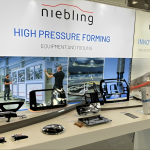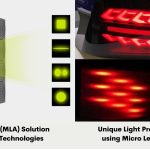Three Emerging Areas in Automobile Where Micro Lens Array Can Be a Game Changer
Introduction
Over the last 130 years, automobile lighting has experienced many changes. From the use of acetylene and oil to light the headlamp in the 1880s to the use of LEDs in 2004. Automotive lighting has come a long way, evolving alongside the latest in lighting technology. To improve the brand’s aesthetic, we now have projection lights and OLED inside the headlight and taillight modules.
Originally, automobile lighting was only used to illuminate the road, but they are now used to improve the vehicle’s aesthetic in a variety of ways. HMI features such as head-up displays, digital instrument clusters, ADAS, and gesture recognition have contributed to modernizing the vehicle. With these ever-changing trends in automobiles, car cabins will be transformed into luxurious spaces that will give passengers accessibility and entertainment. In this blog, we will discuss how Micro-Lens can be a game changer in a variety of automotive applications.
What is BrightView Micro-Lens Array?
Micro lens arrays are one or two dimensions of very small lenses. In most cases, they form a periodic pattern on the substrate, and the microstructure on the film acts as a lens. These micro lenses can be employed in a variety of applications to control and direct light. Any light source output is usually non-collimated, which means it spreads widely. When we place these films in front of a light source, the output shape of the beam can be modified as desired. For easy application, BrightView Technologies provides this micro lens on a film wafer with substrates like PET, PC, and PMMA.
Why Micro Lens Arrays?
Compared to conventional fluorescent and incandescent lamps, LEDs have several benefits, such as a longer lifespan, increased energy efficiency, a smaller lamp, less heat generation, and lighter weight. However, one of the challenges of LED light sources is that they consist of an array of many small diodes that create an intense spot of light which is not desired in most cases. As a result, one of the main challenges in LED design is to create uniformly diffused light while minimizing the loss of light intensity. Some diffusers use a diffusing agent to hide LEDs, while others use solutions like plexiglass or PMMA milky white which has several disadvantages. The diffusing agent scatters the light to give diffusing light reducing light transmissivity at the same time. The diffusing agent should be lightweight and allow for both high and low environmental temperature conditions. Finally, it should be economical to manufacture in high volumes.
BrightView MLAs are excellent replacements for plexiglass, milky white, and cloudy PC diffusers because;
- MLA films diffuse the LED source using microstructures rather than a simple diffusing agent, so the light output can take on different profiles, or be customized.
- This results in light output which is typically 92% transmissive. MLAs improve efficiency – layers are generally thinner, resulting in superior efficiency compared to cloudy diffusers.
- Brightview combines reflection and transmittance in a single film, reducing the cost and scale of the component.
- Micro-Lens Array significantly reduces energy consumption in Electric Vehicles by cutting down on the number of LEDs!
MLAs in automotive
- Interior / Exterior Lighting – Make a statement with LED lights
BrightView has engaged with global Tier 1 and automobile manufacturers for many years in applications in both interior lighting and taillights. Using MLAs in interior lighting, one can hide LEDs in light strips and touch button backlights to create a smooth aesthetic for a modern look within the cabin. Light shaping diffuser films can be used in Map Lights, Puddle Lights, and Cosmetic Mirrors to guide light only where it is needed. Automotive designers are increasingly using taillights as a distinctive design aspect. MLAs outstanding transmission efficiency, reliability and beam shaping options to create that distinctive look. To understand long-term performance, each production run is lot controlled and tested to meet environmental requirements. To learn more about the product line for lighting application please click here.
- Displays with greater brightness and efficiency
2D Mini LED backlights are becoming a popular choice for backlight architecture for HDR (High Dynamic Range) and local dimming in vehicle displays, however, they face design challenges that current solutions cannot address. Edge-lit backlit units are a very cost-effective solution in many types of displays, however the main limitation is their contrast performance. MLAs have many benefits in automotive LCD displays.
In 2D mini LED displays, MLAs can increase brightness and efficiency while making every watt count. MLAs direct the light created in the backlight unit to the LCD panel with excellent efficiency. Fewer and thinner films can be used reducing the backlight thickness while maintaining hiding and brightness.
In edge-lit displays, BrightView’s gain enhancement films can boost the brightness up to 30%. The gain enhancement film replaces the traditional down diffuser.
BVT provides MLAs for PGU (Projection Generation Unit), which plays an important role in managing optics in the HUD unit by shaping the eye box profile. This film produces clearer, brighter HUD images and is compatible with LCD and DLP-based HUDs, as well as next-generation AR HUDs.
To learn more about the product line for display application please click here.
To learn more about the product line for heads-up display (HUD) application please click here.
- 3D Sensing – Efficient and Targeted Field of View
BrightView MLA meets a broad range of 3D sensing specifications, including AR/VR and Biometric sensing. LiDAR detects objects and maps three-dimensional environments around a vehicle using a laser and detector. Flash LiDAR, which often employs an array of lasers and time-of-flight sensors, is reliable and affordable, and a popular choice among automobile engineers. However, the LiDAR light source must be shaped to a specific field of view. BrightView’s microlens array optics are ideal for generating this field of view in combination with a laser source. Many beam shapes and steering angles are available in a variety of form factors and substrates. To learn more about the product line for LiDAR application please click here.
How these films are manufactured and used
MLAs are designed and produced at BrightView. They are manufactured using a high volume roll-to-roll manufacturing process, which ensures high quality and reproducibility. In comparison to diamond turning and holographic processes, BrightView’s unique grayscale lithography technology allows microstructures to be customized quickly and cost-effectively. This technique can combine shape, unique structure, and density to enable multiple functions in a single device, reducing cost and overall size. BVTs conversion capability allows it to cut these films in the desired form and size while maintaining strict quality control.
Reasons to choose BrightView for your Optics need?
Rapid concept prototyping
BrightView can quickly identify the ideal design by doing rapid prototyping and modify the MLA for maximum performance. With a single point of contact, they can take a design from concept to production, keeping work simpler.
Create a design that is customized for your needs
With their extensive knowledge of manufacturing, materials, and optics, BrightView’s development team can swiftly engineer the best solution for your lighting projects. The demands of the customer’s optical design are met by both custom and off-the-shelf MLA solutions.
Lot controlled and inspected production runs
To ensure the highest quality, each manufacturing run is lot-controlled and closely inspected. BrightView products are put through extensive environmental testing to ensure long-term performance relevant to the application. They take a sustainable approach to improving their processes and products to lower their carbon footprint.
Several substrate options available
BVT offers MLA products in a variety of substrates such as PET, PC, and PMMA, as well as thicknesses ranging from 0.08 to 3 mm. Depending on the application, films can be laminated to a rigid acrylic which is 1mm to 8mm thick. Microstructures can also be embossed on acrylic or glass substrates. BVT offers light guide plates and high-performance reflectors which are 96% reflective.
Conclusion
Brighter, more efficient Displays, LiDAR for improved safety, Bright and Crisp Head Up Displays rich in driver-relevant information, and Smooth interior and exterior LED Lighting that creates a unique, signature look are important applications in the vehicles of today and tomorrow. BrightView offers MLA solutions that work to shape and guide light at the quality and quantity to take your design to the next level. As light modules are large and bulky, downsizing is achievable by employing these films. Simply by using these films, one can produce unique light profiles with uniform LED smoothing for a sleek look and increased brightness. It’s only a matter of being innovative and creative about how you utilize these films. As we all know, automobiles will undergo significant transformations in terms of aesthetics, scale, size, and cost, necessitating the use of BrightView Micro Lens Array Films.
Please write to me at prashant@quanzen.com to know more about MLA solution.




